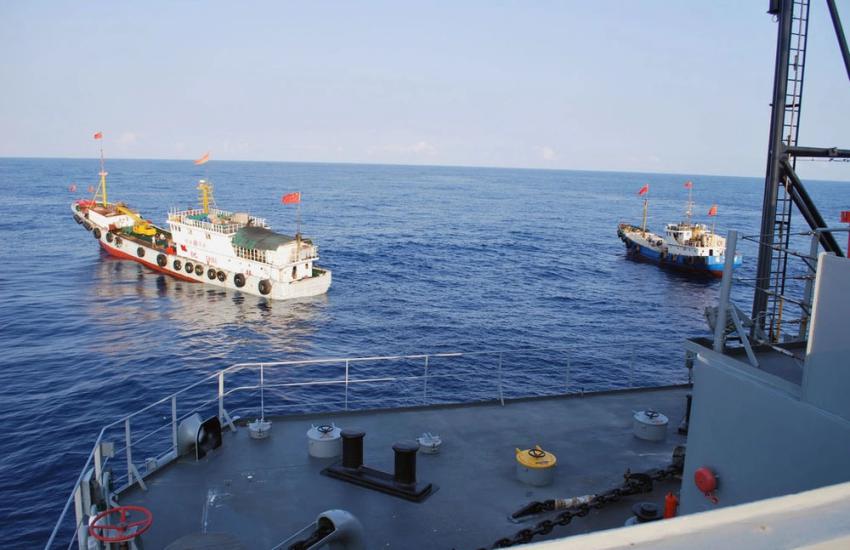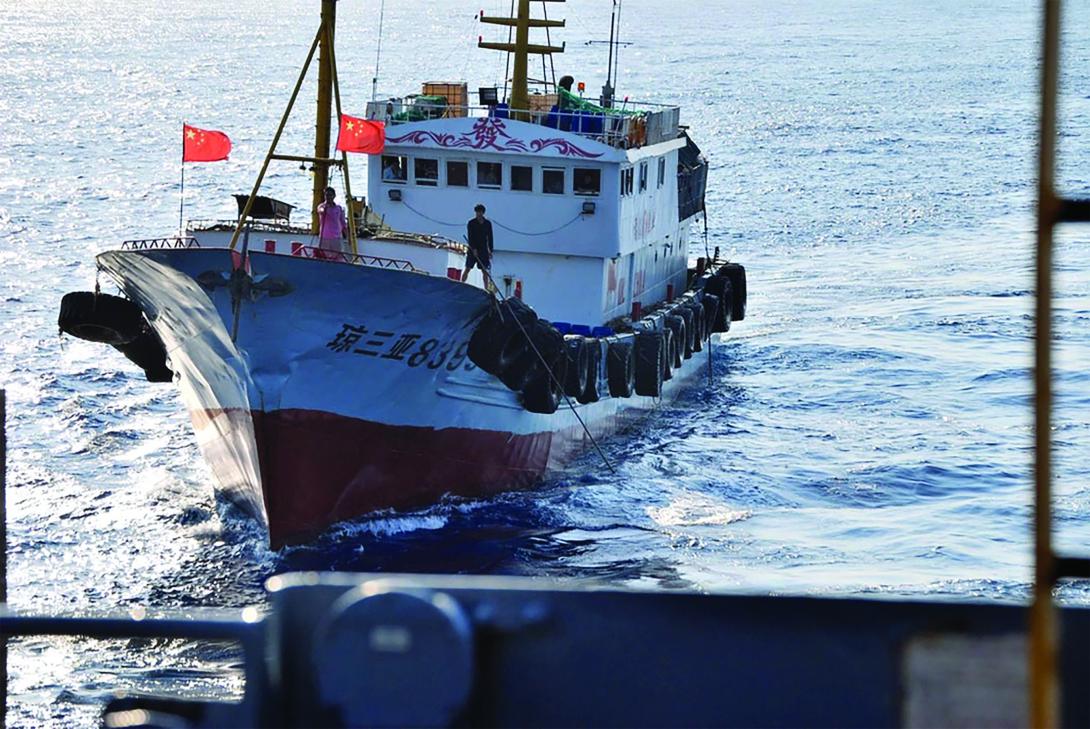Uncovering China’s Fishy Activities at Sea
China employs an opaque second navy that is nominally a civilian fishing fleet but follows orders from its military. The militia has been described by scholars as “a force of vessels ostensibly engaged in commercial fishing but which in fact operate alongside Chinese law enforcement and military to achieve political objectives in disputed waters,” according to a report by the Center for Strategic and International Studies (CSIS), a U.S.-based think tank.
“The Maritime Militia in China is a long-standing organization. It wasn’t formed recently; it was in existence for decades,” said Collin Koh, research fellow at the Institute of Defence and Strategic Studies, a Singaporean academic institution. Koh traced this group’s origins to shortly after the Communist revolution in the 1950s.
This fleet takes advantage of appearing civilian to maximize capabilities in the military realm.
“It simply gives China some level of plausible deniability when it comes to asserting its maritime interests,” Koh said.
But this force, part military and part civilian, is all illegal, experts contend. And many beyond the armed forces are concerned about its operations.
Global Fishing Watch (GFW) is a nongovernmental organization that describes itself as “advancing ocean governance through increased transparency of human activity at sea. By creating and publicly sharing map visualizations, data, and analysis tools, we enable scientific research and drive a transformation in how we manage our ocean.”
This environmental group keeps an eye on the fishing side of China’s Maritime Militia and follows its presence in waters where it should not fish. To accomplish this, GFW uses an array of technologies.
“Globally, there’s a few hundred thousand boats that have [automatic identification] devices, of which about 70 to 100,000 are fishing vessels,” said David Kroodsma, director, Research and Innovation, at GFW.
“They broadcast their [GPS] positions, and we collect a global database of them, and then, we do a lot of big data and machine learning to identify which of those are fishing vessels and when are they fishing,” Kroodsma said.
Through technology, GFW can determine if a ship is taking cargo or fishing, among other possible behaviors. This is not as straightforward as it seems. There are 90,000 active commercial vessels in the world, according to the Global Investigative Journalism Network. Any data gathering of this kind comes with significant amounts of noise.
“So, you end up with a map that has got an awful lot of information in it. It’s global,” said Tony Long, chief executive of GFW and former U.K. Royal Navy officer.
China has used maritime militias for decades. The first widely recognized incident they participated in dates back to a skirmish with Vietnam in 1974 over islands in the South China Sea, a highly disputed body of water China considers mostly its own. Still, many Southeast Asian nations have claims on it.
Since then, the use of this hybrid force has evolved. It employs vessels between 35 to 55 meters in length, according to a report by the CSIS.
This force was involved in harassment of U.S. Navy ships in the region, including the incidents reported in 2002 against the USNS Bowditch and in 2009 with the USNS Impeccable, among many other events violating basic security norms. The pattern has followed acts like reckless maneuvering by nominally civilian Chinese ships, mostly against navy vessels exercising free passage in accordance with international law.
“Beijing’s rewriting of regional and cultural norms, whether its aggressive operations around Taiwan and in the South China Sea, its diplomatic temper tantrums or its economic coercion are a great threat to the international community today,” said Rear Adm. Tom Henderschedt, director for Intelligence, U.S. Navy Indo-Pacific Command, at an AFCEA event in November.
The reach of this group has gone beyond China’s adjacent waters.
“PRC-based firms and individuals engage in illegal, unreported, and unregulated fishing along the outer limits of South American Exclusive Economic Zones. … Each year, over 600 PRC-flagged vessels operate in international waters off the coast of South America. They severely deplete fish stocks and leave plastics and other pollutants in the Galapagos Marine Reserve near Ecuador, costing the region almost $3 billion in lost annual revenue. Such illicit activities not only drain partner nations’ already scarce natural resources, but they also destroy the environment, threaten marine life, and deprive local workers of their livelihood,” stated a House Armed Services Committee Posture Statement from 2022.
Japan’s National Institute for Defense Studies, which is part of its Ministry of Defense, explains the specific missions of the maritime militia. First, the maritime militia takes advantage of its large number and equipment, asserting maritime rights and interests. Secondly, it plays a mediating role between the military, administrative organizations and the civilian sector. In addition, compared to the Chinese Coast Guard and the People’s Liberation Army, maritime militia units play a role in shallow waters, can operate smaller and more mobile vessels, and can conduct a wide range of surveillance activities with many fishing vessels. “The Chinese government may believe that mobilizing the maritime militia can control the escalation of a crisis, rein in the adversary, avoid military skirmishes, and expand China’s effective control,” the institute said in the 2023 edition of its annual China security report.
Hybrid tactics place other states following rules at a disadvantage. “Powers that have an interest in preventing maritime coercion are often only equipped with the blunt instrument of naval power, the deployment of which against ostensible fishing vessels would be both escalatory and impractical,” said the CSIS report.
These vessels, though hidden behind murky legal structures, can sometimes have their deliberately intricate ownership traced. Using open-source information and other data, U.S. experts managed to understand how Beijing finances privateering.
“Existing subsidy policies incentivize the operation of large vessels in disputed waters while providing no incentive to fish. Vessels at least 55 meters in length with an engine power of at least 1,200 kW operating in the Spratly Islands [in the South China Sea] receive special fuel subsidies at a rate of CNY 24,175 (USD 3743.30) per day—a rate which well exceeds operational costs, allowing owners to easily profit by deploying to disputed waters without fishing at all,” states the CSIS report.

But despite this “skillful” bending of regulations, open-source data and China’s predatory fishing practices are starting to diminish this fleet’s advantages.
“Commercial satellite imagery and [automatic identification system] data play an important role in identifying and tracking militia deployments,” according to CSIS.
For open-source activists, the process adds other layers to create better tracking and machine learning to simultaneously process thousands of behavior patterns.
“We have got algorithms for doing that, so I can take the AIS [Automatic Identification System] data; I can tell you which of these detections matched AIS and which ones do not,” Kroodsma said.
As GFW’s computers receive public location and denomination data from AIS, it is currently adding a visual recognition algorithm to add a layer from satellite photographs, said Kroodsma. Other layers are being added as well. “Some of the technology we’re using, I know is used to track activity in the Black Sea, for instance, around Ukraine and Russia,” Kroodsma explained. The organization also exchanges information with navies and other institutions, including the U.S. Navy and Coast Guard, to further expand its data sets.
“Working with Global Fishing Watch, the U.S. Coast Guard, and other U.S. government and international partners will help us to continue to counter [China as a] growing threat,” said U.S. Navy Admiral Craig Faller, Southern Command commander, in a statement.
As more information is shared and analyzed, GFW can determine whether a vessel is involved in fishing or is hiding within a fleet. For GFW, the threat is illegal and overfishing; granting law enforcement in each jurisdiction access to this information is their mission. Nevertheless, a byproduct is identifying vessels involved in unlawful activities.
“We haven’t looked at those fleets,” Kroodsma clarified when asked about China’s Maritime Militia. But employing advanced technology to identify the real intentions of a ship can be used with greater width than the environmental group’s specific conservation interests.
For now, the nongovernmental organization is laser-focused on keeping environmental offenders at bay.
“It’s of real interest to those that are patrolling the seas because if they use the information correctly, they should be able to make reasonable predictions about where they should put their patrols,” Long told SIGNAL Media in an interview.
Still, unexpectedly, open-source technology is starting to limit the secrecy with which this cunning tactic yielded results in the past regarding unlawful behaviors.





Comments